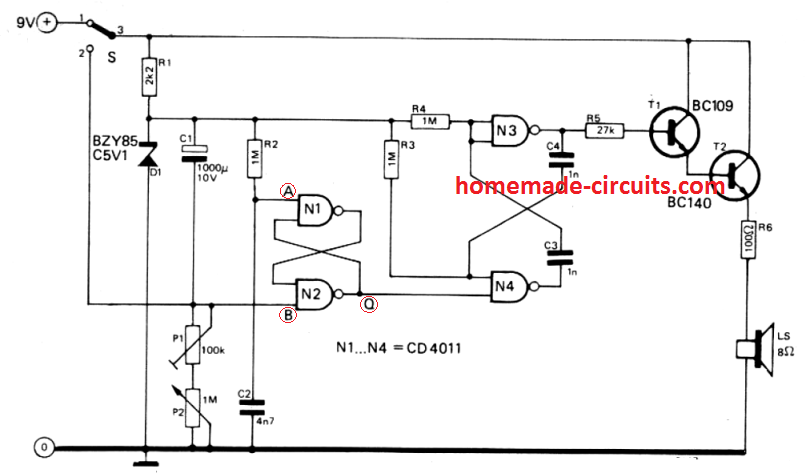A kitchen timer is a useful gadget which produces an alarm sound after a predetermined delay, as set by the user for specific time based food recipes that must be cooked only for a certain amount of time for best results.
Written By: Suneeta Dixit
One example is boiled eggs which may be either hard boiled, medium boiled or soft boiled depending upon how long it is allowed to boil.
For such applications, a kitchen timer can be quite handy, and will provide the user with a warning alarm after the stipulated time is elapsed, so that the user can shut off the flame and avoid the food from getting overcooked or for getting the right desired texture and taste on the food.


How it Works
The kitchen timer circuit with alarm or an egg timer I have explained in this article could be built very cheaply, and it features an adjustable delay time setting between 1 minute and 17 minutes.
Other time ranges may be possible through little alterations. Initially while the circuit is not powered, capacitor C1 and C2 are uncharged.
As soon as the unit is turned on with switch S (position 1), input A of the flipflop N1 /N2 stays temporarily at '0V', to ensure that output Q of N2 turns into 0 and multivibrator N3/N4 is disabled. Next, capacitor C1 begins charging through potentiometer P1 and P2.
Once the voltage at point B becomes lower than the flipflop's switching threshold, the flipflop toggles and this initiates the multivibrator action.
This initializes the square wave frequency from the multivibrator which is amplified by the transistors T1 and T2 and the resulting tone output is reproduced through loudspeaker L.
When the kitchen timer is switched OFF (S moved to position 2), capacitor C1 begins discharging swiftly via resistor R1 to ensure that, once the timer switched on again for the next cycle, no left over charge remains in the capacitor which may otherwise cause reducing the timing length.
How to Calibrate
1. Adjust P1 at the center of its journey and adjust P2 to its minimum setting range. After that readjust P1 to allow a period of 1 minute.
2. Next, set up P2 to its maximum possible range and determine the time interval generated from the circuit.
3. Lastly calibrate the scale of P2 with a linearly increasing scale from a range of 1 minute minimum, and the maximum which was determined practically earlier.
PCB Design and Component overlay



Good day Swagatam, thanks for the post. it is very interesting and useful. I just have a question, since I only have one CD4011, and I dont know if it is in proper working conditions. I would like to ask if i can use CD4017 instead CD4011. Thanks again for the article.
Thank you Jorge, you only require one 4011 IC for this project. However, 4017 cannot be used in place of 4011 since the two are entirely different CMOS ICs.
Swagatam… I request you ckto to reverse the 3 / 4hp single-phase motor turn… start right for 5 mints, stop 1/2 sec and start opposite turn for 5 mins…
and so on for a while … washing machine type, maybe digital analog … thanks
Thank you Marvin, I’ll try to update the washing machine motor design soon in the washing machine article
Man, the subject is excellent and very necessary…. At the output you could put a relay … the combination of the flip flop and the multivibrator is very good and the times can be lengthened or shortened … the magic is the digital-analog hybrid, I am fond of electronics …. I’m looking for a timed reversal turn for 10min, stop 1sec, reverse turn 10 min, stop 1sec and continue… like the washing machine… maybe there is something in the rest of the timers…. I congratulate you very well on your website … greetings
Thanks friend for liking and appreciating my work! I am glad you found the article useful! Please keep up the good work!
Thanks for this timer I think it could be utilized with 1 or 2
LM 4017 to lengthen the time